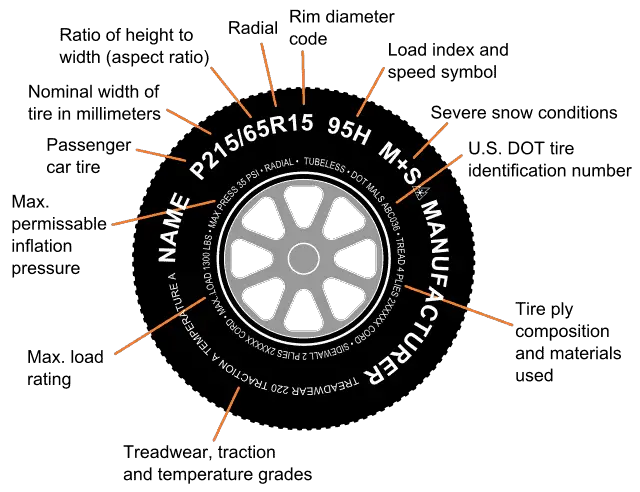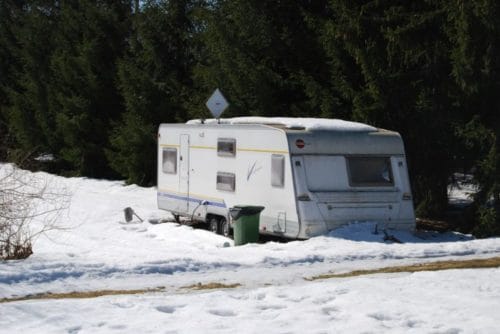Tire Label Reading

For more in-depth information on RV tires, we invite you to visit our sister site, AskTheRVEngineer.com, and begin reading Part 1: The Ultimate Guide to RV Tires. You’ll learn about how to read a tire code, what causes tire blowouts, how to store and maintain your tires, and much, much more!

Tire Speed Rating Table
A tire’s speed rating indicates the optimal speed that the tire can safely maintain over time.
The higher the speed rating, the longer lifespan and better handling you can expect at higher travel speeds.
Certified speed ratings vary from A to Z, ranging from 3 mph (5 km/h) to more than 186 mph (300 km/h).
The rating system (see below) shows the top speed for which a tire is certified. Take note! It doesn’t necessarily indicate the performance capability.
Check your RV owner’s manual for the recommended tire speed rating, and always – repeat: ALWAYS! – use tires at that rating or higher. If your RV doesn’t have its OE tires (or you can’t read the sidewalls), then you can find the recommended load rating in the owner’s manual or the VIN sticker.
Speed ratings only apply to tires that have not been damaged, repaired, under-inflated, or overloaded.
P.S. If you don’t see a tire speed rating on your tire sidewall, it is likely safest to assume that the ST tire is rated for 65 mph.
| Speed Rating | Speed (mph) | Speed (km/h) | Use[s] |
|---|---|---|---|
| G | 56 | 90 | Agricultural equipment |
| J | 62 | 100 | |
| K | 68 | 110 | |
| L | 75 | 120 | Off-road and light truck tires |
| M | 81 | 130 | Spare tires |
| N | 87 | 140 | Spare tires |
| P | 94 | 150 | |
| Q | 100 | 160 | Studded and studless winter tires |
| R | 106 | 170 | Heavy duty light truck tires |
| S | 112 | 180 | Family sedans and vans |
| T | 118 | 190 | Family sedans and vans |
| U | 124 | 200 | |
| H | 130 | 210 | Sport sedans and coupes |
| V | 149 | 240 | High performance sports cars |
| Z | 149+ | 240+ | High performance sports cars |
Tire OEM Load and Inflation Tables
- Michelin RV Tires Load and Inflation Tables
- Goodyear RV Tires Load and Inflation Tables
- Bridgestone Truck Tires Load and Inflation Tables
- Firestone Truck Tires Load and Inflation Tables
- BF Goodrich Truck Tires Load and Inflation Tables
- Hankook Truck Tires Load and Inflation Tables
- Yokohama Truck Tires Load and Inflation Tables
- Continental RV and Truck Tires Load and Inflation Tables
- Maxxis ST Tires Load and Inflation Tables (Scroll Down)
- Toyo Truck Tires Load and Inflation Tables
- Sailun Truck Tires Load and Inflation Tables
- Castle Rock ST Tires Specifications
- West Lake ST Tires Specifications
- Constancy ST Tires Specifications
- Ridgeway Sport ST Tires Specifications
Tire Ply Ratings
| Ply Rating | Load Range |
|---|---|
| 2 | A |
| 4 | B |
| 6 | C |
| 8 | D |
| 10 | E |
| 12 | F |
| 14 | G |
| 16 | H |
| 18 | J |
| 20 | L |
| 22 | M |
| 24 | N |
Tire Load Index Table
The load index number describes how much weight a tire can carry at maximum pressure. Reference the tire load index number to this chart for a maximum weight rating in either pounds or kilograms.
The higher the tire’s load index number, the greater the load-carrying capacity.
To calculate the total weight capacity of an axle or full suspension system, simply multiply the total capacity by the number of tires.
For instance, a single-axle suspension with four tires at a load index of 107 would have 2 x 2,149 lbs = 4,298 lbs.
The math may be slightly different for dual, triple, or tandem axle applications. LT and ST tires may have two load index numbers separated by a forward slash, like this: 104/101.
The first number indicates the weight capacity if the tire is installed on a single axle, and the second number applies when the tire is installed in a dual-axle application. The derated value builds in additional reserve capacity should one of the two tires fail.
Note: The maximum load capacity of the tires may not be their normal operating capacity!
Tire load index ratings are based on the maximum fill pressure, not the manufacturer’s recommended air pressure level, which may be lower depending on carrying conditions.
| Load Index | Lbs | Kg |
|---|---|---|
| 70 | 739 | 335 |
| 71 | 761 | 345 |
| 72 | 783 | 355 |
| 73 | 805 | 365 |
| 74 | 827 | 375 |
| 75 | 853 | 387 |
| 76 | 882 | 400 |
| 77 | 908 | 412 |
| 78 | 937 | 425 |
| 79 | 963 | 437 |
| 80 | 992 | 450 |
| 81 | 1,019 | 462 |
| 82 | 1,047 | 475 |
| 83 | 1,074 | 487 |
| 84 | 1,102 | 500 |
| 85 | 1,135 | 515 |
| 86 | 1,168 | 530 |
| 87 | 1,201 | 545 |
| 88 | 1,235 | 560 |
| 89 | 1,279 | 580 |
| 90 | 1,323 | 600 |
| 91 | 1,356 | 615 |
| 92 | 1,389 | 630 |
| 93 | 1,433 | 650 |
| 94 | 1,477 | 670 |
| 95 | 1,521 | 690 |
| 96 | 1,565 | 710 |
| 97 | 1,609 | 730 |
| 98 | 1,653 | 750 |
| 99 | 1,709 | 775 |
| 100 | 1,764 | 800 |
| 101 | 1,819 | 825 |
| 102 | 1,874 | 850 |
| 103 | 1,929 | 875 |
| 104 | 1,984 | 900 |
| 105 | 2,039 | 925 |
| 106 | 2,094 | 950 |
| 107 | 2,149 | 975 |
| 108 | 2,205 | 1,000 |
| 109 | 2,271 | 1,030 |
| 110 | 2,337 | 1,060 |
| 111 | 2,403 | 1,090 |
| 112 | 2,469 | 1,120 |
| 113 | 2,535 | 1,150 |
| 114 | 2,601 | 1,180 |
| 115 | 2,679 | 1,215 |
| 116 | 2,756 | 1,250 |
| 117 | 2,833 | 1,285 |
| 118 | 2,910 | 1,320 |
| 119 | 2,998 | 1,360 |
| 120 | 3,086 | 1,400 |
| 121 | 3,197 | 1,450 |
| 122 | 3,307 | 1,500 |
| 123 | 3,417 | 1,550 |
| 124 | 3,527 | 1,600 |
| 125 | 3,638 | 1,650 |
| 126 | 3,748 | 1,700 |
Tire FAQs
Where Can I Weigh My RV?
For a simple weight reading of your RV, you can tow or drive it to a certified trucking scale, such as a CAT scale. It is very affordable, usually $10-$20 for the first weighing and $3-$5 for a second or third.
If you want wheel position weighing (which is much more useful), then your options are much more limited.
- RVSEF offers wheel position weighing at FMCA RV rallies throughout the year.
- RV Weigh provides similar on-site wheel position weigh services at campgrounds and rallies.
- Escapees SmartWeigh offers 4-position weighing at RV parks in Texas, Arizona, and Florida.
- Weight to Go offers limited wheel position weighing services in Arizona.
- You may have some luck contacting your state Highway Patrol and requesting wheel position weighing.
Cost for wheel position weighing is typically $45 to $55 depending on type of RV.
Do RV Tires Need to Be Balanced and Aligned?
All vehicle tires, whether on a trailer or motorhome, should be properly mounted and balanced. Unbalanced tires can lead to premature wear and squirrely highway handling.
However, towable RVs generally do not require conventional tire alignment. In fact, most leaf-spring and torsion-axle suspensions do not allow independent alignment of toe, camber and caster.
There are some RV suspension types, such as the Timbren Axle-Less suspension system, that allow limited alignment, such as camber adjustment.
However, motorhome RV tires do require periodic alignment, same as any other passenger vehicle.
Why Are My RV Tires Worn Out?
While there are many potential causes for premature tire tread wear, one stands out above all else: under inflation.
Worn tread edges are symptomatic of under-inflated tires, a common problem when RVs are loaded to their limit.
Worn tread edges on one side indicate excessive camber. If both your tires are worn out on the inside, that is a likely indicator of an overloaded axle.
You should check the tread depth of your tires every 5,000 miles or every 3 months of use, whichever comes sooner. Most tires require a minimum of 2/32 or 3/32 of tread depth (can you see all of Lincoln’s head?). Do not allow a tire tread to become worn past the wear bars.

Andy Herrick is a blogging nerd, #8 Enneagram, wannabe bread baker, INTJ, RV industry professional, and small business entrepreneur. He can be found hanging out with his lovely wife and family, skiing, cycling, climbing, hiking, and convincing anyone who will listen why dogs aren’t really that great of pets. Also, he runs this website.








